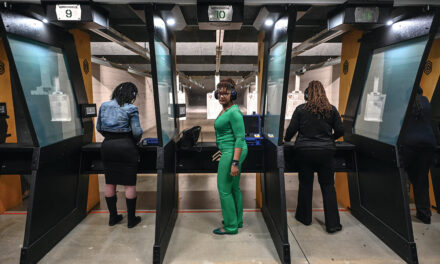
Many of the country’s youngest elected officials hope to express authenticity through their clothing choices.
Wearing a dark green suit from Express and Cole Haan dress sneakers, Representative Maxwell Frost, Democrat of Florida, took the stage at Metrobar in Washington. He was speaking at an event this summer by Run for Something, a political action committee that supports young Democrats seeking state and local office.
“How’s everybody doing?” Mr. Frost, 26, asked a crowd of about 200 people, in which more than one brightly colored Telfar bag could be spotted. A number of attendees, including Mr. Frost, were members of Gen Z, the generation born between 1997 and 2012.
In an interview after his speech, Mr. Frost said that “a cool thing about our generation is that we’re super-open to whatever fashion and whatever creativity people bring to the table.” Much of his professional wardrobe consists of suits, but he has worn bomber jackets and Dr. Martens shoes at more casual events, he said, as well as T-shirts on the campaign trail.
“I feel like there’s a direct connection between Doc Martens, and a certain style, and progressive young people,” Mr. Frost said.
He is the only member of Congress from Gen Z, but others from his generation have been elected to state legislatures and city councils across the country at a time when more young people have been showing up to vote. A 2021 study by the Tisch College of Civic Life at Tufts University found that 50 percent of those 18 to 29 voted in the 2020 election, an 11 percent increase over 2016.
Though Gen Z politicians can often be seen in the type of formal attire that lawmakers have worn for decades — in part because of workplace dress codes that date to before they were born — some said their clothing choices reflect a priority to appear authentic. In a 2021 survey of American Gen Z-ers by the consulting and accounting firm Ernst & Young, 92 percent of participants said authenticity is a priority. That authenticity can be an important tool as these elected officials do the sometimes less visible work of lawmaking.
The House of Representatives and the Senate have rules of procedure, which include governance on how members should dress. But neither chamber has an official dress code.
On the Senate floor, for instance, male lawmakers are expected to wear a jacket and tie. The rules in the House have been relaxed in recent years. In 2017, the chamber started allowing female members to wear open-toed shoes and sleeveless tops or dresses; in 2019, the rules changed to permit head coverings for religious purposes.
State and city governments have their own protocols, some of which have recently drawn attention. A flyer distributed to Florida legislators’ offices in January warned women not to wear skirts that landed more than one inch above the knee at the Capitol in Tallahassee. That same month, the Missouri House updated its dress code, requiring female legislators and staff members to wear jackets; male colleagues have had the requirement for years.
Mazzie Boyd, a Republican in the Missouri House who previously worked in the Trump White House, said her legislature’s new dress code has not stopped her from embracing her personal style at work.
“I wear what I want to wear,” said Representative Boyd, 25, who described her style as country and sophisticated. She favors colorful pieces from brands like Ann Taylor, Ralph Lauren, Calvin Klein and Ivanka Trump’s namesake fashion line, which shut down in 2018.
“I try not to match my skirt with my shirt,” she said. “If I’m doing a tweed skirt, I don’t want to wear the matching tweed jacket. With dresses, it’s the same thing. I’m not trying the exact same color or exact same pattern on every element.”
Ms. Boyd said that her mixing of colors and patterns has caught the attention of some older colleagues, who have commented on how her outfits are a reminder that they “don’t have to wear black on black with a white shirt every day,” as she put it.
“Now, am I saying that people replicate what I wear? Probably not,” she added. “I’m kind of my own gal.”
Caleb Hanna, a Republican in West Virginia’s House of Delegates, also said his clothes could set him apart from colleagues. On Fridays, he said, there is a tradition among some Republican members of the State House of Delegates to wear camel suit jackets, a decades-old ritual in which he has not participated.
“I think that politics today is a lot different from politics of the past,” Delegate Hanna, 23, said. “Politics of the past, especially in West Virginia, has focused on this good-old-boy system, and it was more of a club.”
Mr. Hanna, whose favorite brands include Vineyard Vines, said he liked wearing sports coats but hated ties. “If I’m just walking around the Capitol after we adjourn for the day, usually the first thing that comes off is my tie,” he said. “I’m always trying to get my tie off.”
Chi Ossé, 25, a Democrat from Brooklyn in the City Council, said that he has expressed his personal style at work through clothes with subtle details (a favorite pair of pleated pants from Uniqlo) and accessories (platform leather shoes from Dr. Martens).
Councilman Ossé has also been known to wear a black beret, a style of hat adopted by the Black Panthers, at public appearances, including at a meeting of New York City’s Rent Guidelines Board in June. He started wearing the beret while organizing Black Lives Matter protests in 2020, he said. Later, when he announced his campaign for City Council, it became a way for people to recognize him. “It felt right to wear, and it felt me,” he said.
Mr. Ossé said he has never felt pressure to dress formally, but that when he has worn a suit or a tie, he has been taken more seriously by colleagues and constituents. “People treat you differently,” he said.
Joe Vogel, a Democrat in Maryland’s House of Delegates, said choosing what to wear has often required a careful balance.
Delegate Vogel, 26, who is running for an open congressional seat in 2024, said that he looks “a little bit more relatable” when he doesn’t wear jackets. His Adidas Stan Smith sneakers, he added, are a staple on the campaign trail. When he does wear a shirt and tie, he will often roll up the sleeves to appear more casual.
Leaders of Run for Something and Run GenZ, an organization that supports young Republicans running for state and local office, said the groups encourage candidates they support to wear clothes that will boost their confidence.
“Our advice is to dress up, but that doesn’t mean you cannot be able to express yourself as well,” said Joe Mitchell, 26, the founder of Run GenZ and a former Republican Iowa State representative. When he was in office, he added, “I felt like I could look the part even when I was back home going to a county party central committee meeting wearing a flannel shirt, jeans and tennis shoes.”
Amanda Litman, a founder of Run for Something, said that her organization supports female candidates, L.G.B.T.Q. candidates and candidates of color who, as she put it, “can’t pretend to be like the rich, old white men of yore.”
“They can only be who they are,” Ms. Litman said. “They are just unwilling to pretend in a way that is really appreciated.”
And it’s not only Gen Z politicians who are dressing more casually.
Gov. Gretchen Whitmer of Michigan, 52, a Democrat, likes wearing pink — fuchsia, to be precise. The House speaker, Kevin McCarthy, 58, Republican of California; Senator Mitch McConnell, 81, Republican of Kentucky; and Representative Hakeem Jeffries, 53, Democrat of New York, all recently wore dress sneakers to a meeting at the Oval Office. It is hard to picture Senator John Fetterman, 54, Democrat of Pennsylvania, in anything other than hooded sweatshirts and shorts.
Representative Sara Jacobs, 34, Democrat of California and a millennial, said she thought many elected officials now made appearing authentic a priority, “over some generic standard of what a politician has historically looked like.”
In June, members of the recently formed Congressional Sneaker Caucus, which is led by Representative Jared Moskowitz, 42, Democrat of Florida, and Representative Lori Chavez-DeRemer, 55, Republican of Oregon, hosted the first Sneaker Day on Capitol Hill.
“We don’t wear powdered wigs anymore in Congress,” Mr. Moskowitz said. Bringing some youth fashion and youth culture to Capitol Hill, he added, is “not a revolution; it’s an evolution of how we dress.”
Nabeela Syed, 24, a Democrat in the Illinois House, said she has typically worn white sneakers to work — she also favors Adidas Stan Smiths — because she makes dressing comfortably a priority. White sneakers, she said, have been a wardrobe staple since she was in high school.
“I’m still sticking to what has been me throughout,” Representative Syed said. “To what feels like me.”




